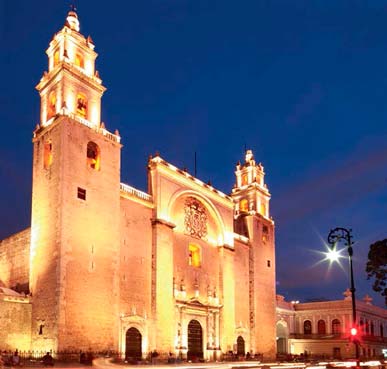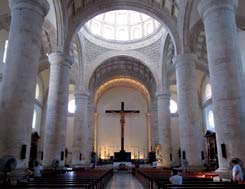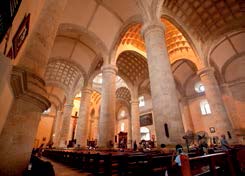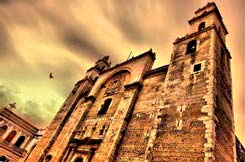 Mérida Cathedral, Cathedral of San Ildefonso in Mexico, was built in the sixteenth century and in a fairly short period if you take into account the majesty of the work. Since the beginning of its construction in 1561 until its completion in 1598 --- some researchers agree that in 1599 --- has been a matter of constant controversy. Some say it was an initiative of King Philip II the start of construction, but others assert that the bishop Francisco del Toral asked the king its construction.
Mérida Cathedral, Cathedral of San Ildefonso in Mexico, was built in the sixteenth century and in a fairly short period if you take into account the majesty of the work. Since the beginning of its construction in 1561 until its completion in 1598 --- some researchers agree that in 1599 --- has been a matter of constant controversy. Some say it was an initiative of King Philip II the start of construction, but others assert that the bishop Francisco del Toral asked the king its construction.
Whatever the reality, one thing is certain and indubitable: the construction begins after the Pope Pius IV issued the authorization on November 16, 1561.
 The authorship of the architectural work was initially attributed to Pedro de Aleustía, and the work is continued by Juan Miguel de Agüero, Cuban architect, who led the construction to a happy ending. It is also said that the original plans were brought by the Bishop Toral directly from Ubeda, city of the province of Jaén. The truth is that for the city of Merida, the Yucatan, is a landmark building and a genuine local pride. Nobody doubts its quality of being the first mainland cathedral. The oldest is that of Santo Domingo, built in 1521. For a long time it was ensured that the magnificence of the building was caused by an administrative error, because their plans were for Lima, Peru, but serious research, as the ones done by sacrum art historian Miguel A. Bretos, showed that is not so.
The authorship of the architectural work was initially attributed to Pedro de Aleustía, and the work is continued by Juan Miguel de Agüero, Cuban architect, who led the construction to a happy ending. It is also said that the original plans were brought by the Bishop Toral directly from Ubeda, city of the province of Jaén. The truth is that for the city of Merida, the Yucatan, is a landmark building and a genuine local pride. Nobody doubts its quality of being the first mainland cathedral. The oldest is that of Santo Domingo, built in 1521. For a long time it was ensured that the magnificence of the building was caused by an administrative error, because their plans were for Lima, Peru, but serious research, as the ones done by sacrum art historian Miguel A. Bretos, showed that is not so.
The continuity of its construction was not permanent. It is true that between the management of Bishop Toral and his successor Fray Diego de Landa the constructive rhythm of the building was maintained, which continued in the bishopric of Fray Gregorio de Montalvo but when the bishopric of Fray Juan Izquierdo began, the construction became very slow, because apparently it was not a priority of his administration. This is probably due to the economic situation of the peninsula at the time. The building had a total cost of two hundred and forty thousand dollars, which was an immense amount at that time. In addition, the bishop thought that the work was a waste: only three hundred Spaniards lived in the city. Another factor that influenced in the delay of the construction was the death of the architect Agüero in 1590. But the fact is that, by the end of the sixteenth century, Mérida already had its cathedral.
 Architecturally, the cathedral itself assimilates various styles. Its facade is Renaissance, but its interior is both Gothic elements as casetondos, which aim is to reduce the weight of the vaults. The interior style reminds by far the Herrera style, very similar to the Chapel of San Lorenzo, in El Escorial. The portico of the Door of Forgiveness is neoclassical. The choir was built much later; it was added to the building the architect Manuel de Arrigunaga y Gutiérrez in the nineteenth century, which bears no architectural relation to the rest of the building.
Architecturally, the cathedral itself assimilates various styles. Its facade is Renaissance, but its interior is both Gothic elements as casetondos, which aim is to reduce the weight of the vaults. The interior style reminds by far the Herrera style, very similar to the Chapel of San Lorenzo, in El Escorial. The portico of the Door of Forgiveness is neoclassical. The choir was built much later; it was added to the building the architect Manuel de Arrigunaga y Gutiérrez in the nineteenth century, which bears no architectural relation to the rest of the building.
Our church had for a long time a monumental clock, built in London in 1731, which operated until 1871 when, due to the construction of the municipal clock in the tower of the City of Mérida, and since they never worked in unison and bells were heard late, causing negative comments of the population, the dismantling of it was decided.
Another important element is the shield at the top of the facade. Originally there was a Spanish royal shield, but at the end of the War of Independence, was deleted with chisel blows and instead one that corresponds to the ephemeral Empire of Agustín de Iturbide was carved.
 In the twentieth century, the distinguished archaeologist Victor Segovia Pinto made a sensational discovery. In the sixteenth century Landa consigned that "the Indians voluntarily went to the offices only in the open chapel of Dzibilchaltun and the Merida cathedral ". Victor Segovia tells: "One morning, carefully watching the towers of the cathedral, there was the cause, I realized that in the second section of the towers were two feathered serpents coiled themselves. Sure, they came there to worship their own God! ". And, since the festive character of Victor, he let out a loud laugh.
In the twentieth century, the distinguished archaeologist Victor Segovia Pinto made a sensational discovery. In the sixteenth century Landa consigned that "the Indians voluntarily went to the offices only in the open chapel of Dzibilchaltun and the Merida cathedral ". Victor Segovia tells: "One morning, carefully watching the towers of the cathedral, there was the cause, I realized that in the second section of the towers were two feathered serpents coiled themselves. Sure, they came there to worship their own God! ". And, since the festive character of Victor, he let out a loud laugh.
Surrounded by urban legends, starting fierce arguments over it, our cathedral is and will remain a great pride in Merida!
Related Publications

How Harumi Yamaguchi invented the modern woman in Japan
March 16, 2022
Giovanni Duarte and an orchestra capable of everything
August 26, 2020










